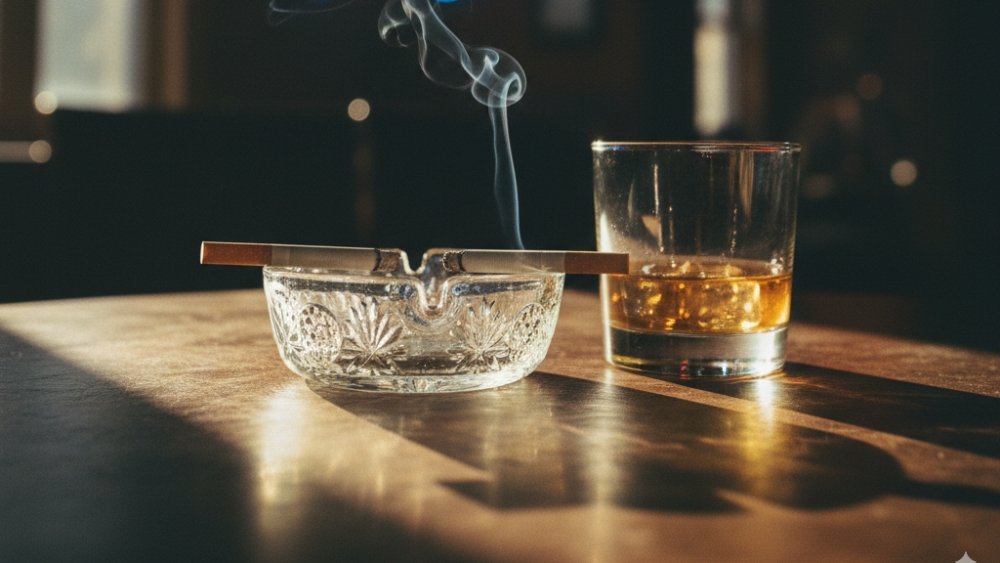When you walk into any tobacco shop, you’ll notice two main types of cigarettes on the shelves: those with filters and those without. But what really sets them apart? The answer goes way beyond just that little white tip. Cigarette filters completely change how tobacco tastes and feels when you smoke it. While filtered cigarettes give you a smoother, more controlled experience, unfiltered ones deliver the raw, intense flavor that tobacco purists swear by. Light cigarettes and Canadian ultra light varieties take things even further, offering an ultra-mild smoking experience for those who want something gentler.
What Are Cigarette Filters and Unfiltered Cigarettes? How Do They Actually Work?
Let’s start with the basics. A cigarette filter is that spongy white or tan tip you see on most modern cigarettes. It’s usually made from cellulose acetate – basically, tiny synthetic fibers packed together. When you take a drag, the smoke has to pass through thousands of these microscopic fibers before reaching your mouth. This process traps some of the tar, ash particles, and other stuff that would otherwise go straight into your lungs.
Basic Filter Construction and How It Functions
Think of cigarette filters like a really fine mesh screen. The tighter the weave, the more stuff gets caught. Most standard filters are about 20–30 millimeters long and made from cellulose acetate tow (continuous fibers). Some premium brands even add activated charcoal or other materials to boost the filtering power.
Unfiltered Cigarette Structure
Unfiltered cigarettes, on the other hand, are just rolled tobacco wrapped in paper – nothing fancy. What you see is what you get. The tobacco burns directly, and the smoke travels straight from the burning tip to your mouth without any interference. This design has been around for centuries and gives you the most authentic tobacco experience possible.
Impact on Smoke Composition Through Different Designs
Here’s where things get interesting. Cigarette filters don’t just make smoke feel different – they actually change what’s in it. Filters reduce machine-measured tar and nicotine yields, but actual intake varies with how people smoke (no single universal percentage). But here’s the catch: your body often compensates by taking deeper drags or smoking more frequently. Unfiltered cigarettes deliver everything the tobacco leaf has to offer, which means more intense flavor but also more of everything else.
The filtering process affects taste in ways most people don’t realize. Those fibers don’t just catch particles – they also absorb some of the oils and compounds that give tobacco its distinctive flavor. That’s why many longtime smokers say filtered cigarettes taste “muted” compared to unfiltered ones.

Do Filtered and Unfiltered Cigarettes Really Taste and Feel That Different?
The short answer? Absolutely. The difference is like comparing a strong black coffee to one that’s been watered down and run through a paper filter. Both are coffee, but the experience is completely different.
| Aspect | Filtered Cigarettes | Unfiltered Cigarettes |
| Tobacco Flavor Intensity | Mellowed and filtered | Bold and direct |
| Mouth Feel | Smoother with less bite | Sharp with full impact |
| Draw Resistance | Moderate resistance, controlled flow | Easy draw, unrestricted |
| Smoke Temperature | Cooler on intake | Noticeably hotter |
| Throat Sensation | Gentler, less harsh | More pronounced kick |
| Aftertaste | Lighter, fades quickly | Rich and lingering |
| Lung Impact | Softer hit | Strong, immediate sensation |
The most obvious difference is intensity. Unfiltered cigarettes hit you with the full force of the tobacco – it’s like getting the director’s cut instead of the TV-edited version. The flavor is richer, more complex, but also more challenging. Your throat and lungs definitely feel it more.
Filtered cigarettes smooth out those rough edges. The filter cools down the smoke and removes some of the harshest elements. This makes them easier to smoke, especially for people who aren’t used to strong tobacco. But some smokers feel like they’re missing out on the “real” tobacco experience.
How Do Light Cigarettes and Canadian Ultra Light Compare to Regular Filtered Options?
Now we’re getting into the specialized territory. Light cigarettes and Canadian ultra light varieties represent the mildest end of the smoking spectrum. They use advanced filtering technology and design tricks to deliver an even gentler experience than regular filtered cigarettes.
| Feature | Regular Filtered | Light Cigarettes | Canadian Ultra Light |
| Tar Content | 8–10 mg | 4–8 mg | 1–3 mg |
| Nicotine Level | 0.6–1.0 mg | 0.3–0.6 mg | 0.1–0.3 mg |
| Filter Technology | Standard acetate filter | Enhanced filter plus ventilation | Multi-layer filter with extensive ventilation |
| Air Hole Design | None or minimal | Strategic air holes | Numerous micro-perforations |
| Taste Strength | Medium to strong | Noticeably milder | Very subtle |
| Smoke Density | Standard thickness | Somewhat diluted | Highly diluted |
| Draw Characteristics | Normal resistance | Slightly easier | Very easy pull |
| Target Users | General smokers | Those seeking reduction | Beginners or ultra-light preference |
The secret behind light cigarettes and Canadian ultra light varieties isn’t just better filters – it’s also about air dilution. These cigarettes have tiny holes near the filter that let in outside air when you take a drag. This dilutes the smoke, making it less concentrated. Canadian ultra light cigarettes take this concept to the extreme, with so many air holes that the smoke becomes very mild indeed.
However, there’s a catch that many smokers discover the hard way. Because the smoke is so diluted, some people end up taking deeper drags or covering the air holes with their fingers (often without realizing it). This can actually increase the amount of harmful substances they inhale, defeating the purpose of choosing a “lighter” cigarette.

How Can You Pick the Right Cigarette Type for Your Personal Taste: 6 Steps
Choosing the appropriate type of cigarette isn’t very complex, but it does require that you be truthful with yourself. Here is a practical approach that can assist you in determining the best thing for yourself.
Step 1: Evaluate Your Taste Preferences
Begin by considering what you desire out of the smoking experience. If you enjoy robust, strong tastes in foods and beverages, you will likely enjoy unfiltered cigarettes. If a milder taste is more to your liking, filtered cigarettes or lights can be the way to go. Decide if you desire an aftertaste that lingers on the palate or one that quickly disappears once the smoking is done.
Step 2: Analyze Your Smoking Habits and Frequency
Notice the way that you yourself smoke. If you smoke frequently throughout the day, the lighter cigarettes might be more gentle on your system. If you have a habit of long drags, filtered cigarettes can diminish the punch a few notches. If one smokes slowly and savors every cigarette, he often prefers the unfiltered variety since he can actually taste the tobacco.
Step 3: Consider Your Physical Sensitivity
Tell the truth concerning the response of your body to smoke. If throat sensitivity or respiration problem exists, begin with the weakest available type – quite possibly Canadian ultra light cigarettes. If one is a beginner smoker, one do not start with unfiltered cigarettes. Even regular smokers might want to think twice about tolerance levels if they upgrade to another kind of cigarette.
Step 4: Match Your Lifestyle and Social Situations
Think about where and when you smoke. In buildings or around non-smokers, lighter cigs will smell much less. If you mostly smoke alone, just choose whatever feels good to your taste buds. Somewhere might require that you get milder smokes, but when by yourself, it’s the opportunity to have a strong, unfiltered cig.
Step 5: Plan Your Testing and Transition Strategy
Don’t expect that ideal cig the very first time. Just be prepared to test different ones for at least one week – the body and taste buds have to get used to it. And if you’ve been moving on from heavy to light, do it slowly. The body needs to get used to those changing amounts of nicotine and tar. And seriously, take notes of likes and dislikes on everyone.
Step 6: Make Your Final Decision Based on Overall Experience
Try various options and consider all of the above factors as a whole. The “best” cigarette is the one that provides the type of enjoyment that you seek and suits your lifestyle. Don’t hesitate to have 2-3 various types on hand to accommodate various moods or situations. Preferences often evolve with the smoker over time, so be sure to branch out and try something new every once in a while.
Frequently Asked Questions about Cigarette Filters
Q1: Do Cigarette Filters Actually Make Smoking Safer?
A: Because filters resolve some of the particles and some of the tar, no brand of cigarettes is completely “safe.” Light cigarettes and Canadian ultra lights can be false security because people compensate by smoking otherwise.
Q2: Why Do Veteran Smokers Prefer Unfiltered Cigarettes?
A: Most believe filters take away the real tobacco essence they desire. Filter cigarettes have a taste to them that is “watered down” versus the smooth, full taste of the unfiltered type.
Q3: Does Switching Cigarette Types Change Smoking Habits?
A: Your body adapts to different amounts of nicotine. Downgrading to milder forms will usually lead to smoking more frequently, and stronger forms will result in more extreme drags.
Find Your Ideal Smoking Vibe
Select between filtered and unfiltered smokes, and it just boils down to whatever you like and how you live. If you like the punch of the unfiltered cigs or the smooth Canadian ultra lights, it just depends on whatever works for you. Ready to discover the one that suits you the best? Jump into sampling various types with our simple guide and determine the one that works for you today.



